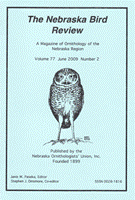Nebraska Ornithologists' Union

Nebraska Bird Review
Date of this Version
9-2024
Document Type
Article
Citation
Nebraska Bird Review, volume 92, number 3, September 2024, pp. 128–131
Abstract
In late November or early December 1967, Roger Guenther harvested a Common Eider (Somateria mollissima) on Maloney Canal between Maloney and Sutherland in Lincoln County, Nebraska. The head and a single foot from the carcass were deposited at the University of Nebraska State Museum via the University of Nebraska–Lincoln and the Nebraska Fish and Game Department (now the Game and Parks Commission). Dr. Jean Tate prepared the parts, which were inventoried as specimen #ZM-12341 in the UNSM. Dr. Paul Johnsgard purportedly took this specimen to the Field Museum of Natural History in Chicago for identification purposes, and concluded the specimen belonged to the race S.m. sedentaria. These events are summarized in Tate (1969) and the occurrence of this subspecies in Nebraska has been cited numerous times in the literature.
Common Eider has seven recognized subspecies (Baldassarre 2014), four of which are found in North America: Pacific Common Eider (S. m. v-nigrum), Atlantic Common Eider (S. m. dresseri), Northern Common Eider (S. m. borealis), and Hudson Bay Common Eider, (S. m. sedentaria). Given Nebraska’s longitudinal proximity to Hudson Bay, S.m. sedentaria may seem like the logical subspecies to wander into Nebraska.
In August 2022, the lead author, after reviewing photographs of the specimen on the Birds of Nebraska–Online website, communicated in an email that he believed Nebraska’s lone Common Eider record was assigned to the incorrect subspecies. Specifically, he considered that the bill processes, referring to the shape of feathers around the bill, are not consistent with S.m. sendentaria.
. . .
We conclude the Nebraska Common Eider specimen was originally misidentified and is, in fact, S. m. v-nigrum. Our reevaluation of Nebraska’s Common Eider subspecific identification provides an important correction to the state’s ornithological record and to the species’ subspecific historical distributional record.
Included in
Ornithology Commons, Population Biology Commons, Poultry or Avian Science Commons, Zoology Commons


Comments
Published by the Nebraska Ornithologists’ Union, Inc.